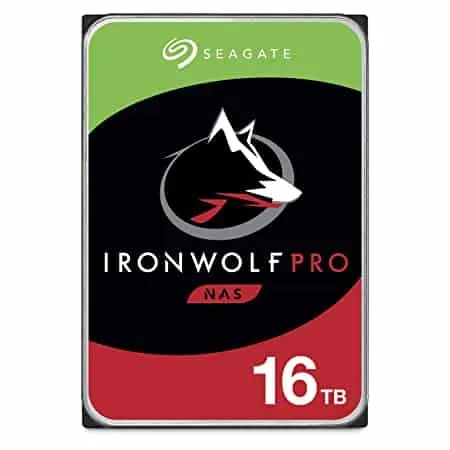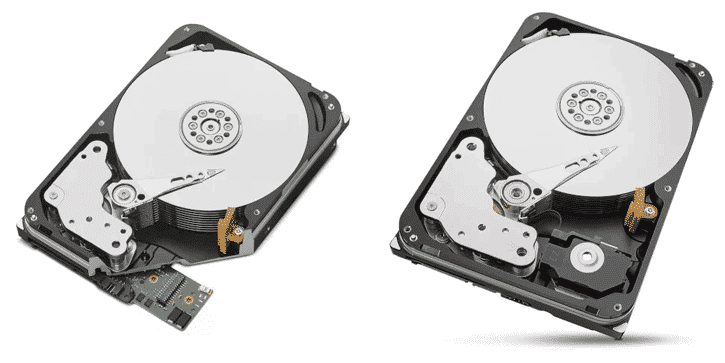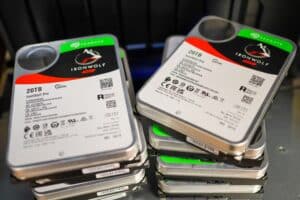The 20TB IronWolf Pro from Seagate is a CMR drive that uses Helium technology to pack 10 x 2TB platters. And 20 heads onto a 3.5 format drive with a height of just 26.11mm. The drive features a 7,200rpm speed and 256MB of capacity. Seagate claims a maximum transfer rate of 285MB/s and an average latency of 4.16 milliseconds.
The 20TB IronWolf Pro is rated at 1W standby, 1W sleep, 5.5W average idle, and 7.7W average active, according to Seagate. The standby and sleep power consumption numbers are lower than the previous 18TB IronWolf Pro. The new drive’s average idle power consumption has increased from 5.2W to 5.5W, the operating power has decreased from 8W to 7.7W.
The drive’s declared workload rate is 300TB/year, with an MTBF of 1.2M hours, which is the same as the previous 18TB flagship drive. Seagate offers a 5-year guarantee on the drive.
What you will see here
Price of IronWolf Pro 20TB

The UK MSRP for the Seagate IronWolf Pro 6 TB is around £740, while the US is $710. Prices increase with the increase in storage options.
Design of IronWolf Pro 20TB

It’s mostly pointless to discuss the Seagate IronWolf Pro 20TB’s exterior. It looks similar to any other Seagate IronWolf drive in the 3.5-inch size factor from the outside.
In a conclusion, it’s a 670g block of metal that contains a CMR 7200 RPM hard drive with ten 2TB platters and 20 heads, all moving under a factory-sealed helium environment. It has 256MB of cache, a five-year guarantee, and Rescue Data Recovery Services for three years. The MTBF (Mean Time Between Failure) is 1.2 million hours, with a 300TB annual workload.
The introduction of RV sensors, unique accelerators that can be used to compute adjustments depending on temperature changes, is an important component of this design. Even slight changes in the size of parts may have an impact when data density levels are this high, and our design has that covered.
Performance – IronWolf Pro 20TB
The 20TB could read and write at more than 285MB/s. That’s a roughly 10% increase more than the old one, which is about the same as the capacity increase.
However, if you want high IOPs, you should invest in SSDs rather than hard discs. It is expected that the 20TB drive to use more power and generate more heat, given the performance increases.
Apparently, the 20TB draws a bit more power while idle than the 18TB, 5.5W vs. 5.2W. However, it uses less power when running. The standby power level is also lower, dropping from 8W on the 18TB to 7.7W on the 20TB. However, we don’t know how many of these drives you’ll need to make this into a big cost-benefit. The fact that they’re more power-efficient is a good thing.
Workload
One feature of the IronWolf Pro 20TB bothers us, and that is the workload definition of 300TB per year.
It is found that these figures were realistic because the workload value isn’t the same as a TBW number on an SSD, as the 300TB represents each year of usage up to five years.
However, if calculation is done, taking 300TB and multiplying it by the five-year warranty period, one gets a guaranteed operating maximum of 1500TB. When one divides it by the capacity, the total bytes sent per TB of storage is just 75TB.
As a result, where an SSD’s TBW just examines writes, this workload includes reads as well as writes as part of the rate, which is stressful. Those who use this drive in any system that does a weekly data quality check will reach the workload limit in four months, regardless of how they use it.
If the drive fails after exceeding these workload limits, Seagate has the right to refuse warranty replacement. It’s important to note that this workload definition isn’t unique to Seagate; it’s the same for Western Digital drives, and the workload values for the Red Pro 20TB aren’t different.
This is less than the UltraStar DC HC560, WD Gold, and Seagate EXOS 20TB’s 550TB/y workload. The average duration of all of these drives is low when compared to even a cheap SSD.
Competitors

Seagate joined Western Digital in bringing their 20TB goods to market, removing any exclusive title on this size of the disc.
Western Digital’s consumer, enterprise, and datacenter NAS and datacenter products are the WD Red Pro, WD Gold, and UltraStar DC HC560. The MSRPs for them are £ 565.99 ($499.99), £549.99 ($559.99), and £456.99 ($699.99).
However, the WD Red Pro 20TB, which directly competes with the Seagate IronWolf Pro 20TB, is considerably cheaper, at least at the MSRP level. Along with the IronWolf Pro, Seagate also has a 20TB EXOS drive, which we’ll look at soon, aimed at the same Enterprise market as the UltraStar DC HC560.
However, for the process being, the other competitor is the decreasing cost of 18TB and 16TB mechanisms. And how they may wind up being a less expensive choice for people who can gain enough capacity using them.
Conclusion
The IronWolf Pro 20TB offers a number of compelling reasons to pick it over the 18TB model. However, it is examine other choices that aren’t mainly for the commercial and business NAS sectors. Based only on the relatively modest 300TB/y workload. In short, the Iron Wolf Pro needed to be less expensive. But Seagate refused to lower the price of the 18TB.
Read More
- External Hard Drive for Mac – 6 best Hard Drives to buy!
- All you need to know about keyboard tablet cases!
- How to cancel Amazon Prime Subscription- End your membership!
- Simple ways to use iCloud Drive on iPhone and iPad!
- How to manually create folders and move documents in the Files app and iCloud Drive?
















